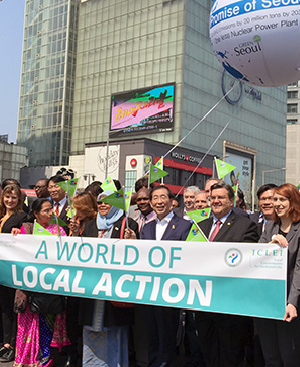- Home
- Reporting entities
- City of Richmond, BC
City of Richmond, BC
Canada Mayor: Malcolm Brodie-
Population 190473

-
Area 129.27km 2
-
GDP N/AN/A
-
Targets by N/A N/Aemission
Targets by City of Richmond, BC
There are no targets yet
- Start year: 2010
- Type: Education/Awareness Raising
- Status: In operation
The Energy Knowledge Program formalizes existing city initiatives pertaining to building energy awareness and encouraging behavioural changes. It is anticipated that the establishment of a dedicated program will enable greater focus to be placed on engagement, thereby, achieving more results through greater collective efforts. The Energy Knowledge Program currently has one target focused on raising awareness corporately. A community-based target may be considered following the completion of the Community Energy and Emissions Plan.
Read More Read Less- Start year: 2010
- Type: Policy/Strategies/Action Plans
- Status: In operation
The City will engage in programs and actions to achieve a 33% reduction in community GHG emissions by 2020 and 80% by 2050 (from 2007 levels).
Read More Read Less- Other Emissions
- Start year: 2011
- Type: Policy/Strategies/Action Plans
- Status: In operation
The Solid Waste Strategic Program proposes two targets for the City of Richmond: 1) To achieve a community-wide waste diversion rate of 70% by 2015, and 2) To develop a corporate waste diversion target by the end of 2012. These targets will be achieved through actions directed towards three core strategies: Reduce, Reuse and Recyle.
Read More Read Less- Waste
- Start year: 2006
- Type: Policy/Strategies/Action Plans
- Status: Completed
The City of Richmond seeks to be a leader in incorporating innovation and leading-edge technology in the management of its fleet, and manage its corporate fleet according to the Green Fleet objectives and performance standards related to acquisition, operational safety and efficiency, education and awarenss, and monitoring and reporting.
Read More Read Less- Transport
- Start year: 2004
- Type: Policy/Strategies/Action Plans
- Status: Completed
The City of Richmond has been incorporating high performance characteristics into our corporate facilities for a number of years. The Sustainable High Building Performance Policy for City owned facilities strives to strengthen previous practice by formalizing corporate commitment to full-cost evaluation (e.g. short and long-term costs); establishing specific management objectives for guiding City decision-making and adopting nationally recognized standards by which to measure building performance and report corporate success. The Policy also serves as the foundation for more sustainable building construction for the City of Richmond and in the City realizaing its vision of being the most appealing, livable, and well managed community in Canada.
Read More Read Less- Buildings
- Start year: 2010
- Type: Education/Awareness Raising
- Status: In operation
The City has undertaken various activities which have raised corporate awareness about the potential impacts of climate change both on the corporate and community levels. The program proposes two targets focused on raising awareness corporately (within the City government) and on raising awareness in the community: 1) To have all City Managers and other key personnel undertake climate change Awareness education by 2012, and 2) To have 100% of elementary students engaged in a select grade in Climate Change Showdown by 2013. By adopting these two targets, resources are directly to focus on various actions that will have contribute to achieving these targets and synergies are built through finding the most opportunistic ways to achieve these targets.
Read More Read Less- Other Emissions
- Start year: 2010
- Type: Policy/Strategies/Action Plans
- Status: In operation
The City will engage in programs and actions to achieve carbon neutrality in City government operations by 2012.
Read More Read Less- Other Emissions
- Start year: 2000
- Type: Policy/Strategies/Action Plans
- Status: Completed
The Urban Forest Management Strategy consists of three basic goals: Tree Conservation, Urban Forest Enhancement,a nd Community Stewardship. The Strategy also serves as the prime vehicle for integrating together various initiatives that promote urban forests and protect city owned trees (e.g. beautification projects, tree donation and nursery, etc). The Strategy also establishes further implementation actions to achieve a cooperative, coordinated, intra-departmental approach towards safe, efficient, and sustainable management of our publicly owned trees.
Read More Read Less- Start year: 2010
- Type: Policy/Strategies/Action Plans
- Status: In operation
The Adaptation Plan would identify projected impacts in Richmond, establish corporate and community resiliency targets and develop an action and implementation plan.
Read More Read Less- Human health
- Start year: 2011
- Type: Technical/Infrastructure investment
- Status: Completed
The City of Richmond purchased the last remaining piece of Richmond’s northeast bog forest as a major contribution towards advancing community sustainability. The purchased bog forest is a significant addition to the City’s parks and open space network. Its six hectares (15 acres) in size adds directly to the adjacent City-owned 13 hectare (33 acre) bog forest creating, in total, a 19 hectare (48 acre) park land forest. Natural park areas of this size support the preservation of Richmond’s unique island environment and provide community access to experience local natural areas. The Lesser Lulu Bog is unique to Richmond and the bog forest purchase preserves the last remaining piece. Natural areas and bogs, in particular, also help address climate change by serving as carbon sinks – absorbing and retaining carbon dioxide, and reducing levels in the atmosphere.
Read More Read LessThe City of Richmond, BC has reported 1 Community emission inventory, since 2007. In its latest inventory, compiled in 2007, the Transport, Stationary energy and Waste management are identified as key emission sources.
The City of Richmond, BC has reported 3 government operational inventories, since 1995. In its latest inventory, compiled in 2007, the Transport, Waste management and Other are identified as key emission sources.
Mayor Malcolm BrodieCity of Richmond, BC, Canada


